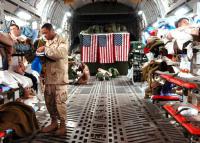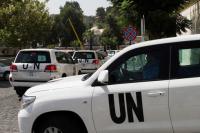-
A momentous peace deal with the FARC – so what next for Colombia?

After more than fifty years of armed conflict, and four years of negotiations, the Colombian government and the leftist guerrilla group, the FARC, have reached a final peace agreement. The historic deal looks set to bring to an end the longest running war of recent history. The agreement is cause for huge celebration, but an official end to war with the FARC is only the start of the road to peace. Both ex-guerrillas, and military personnel who may have to leave the armed forces due to budget cuts, will now face the difficulties of a transition into civilian life. Reintegration programs are crucial not only for former combatants but also for those who have served their country for years. Securing peace therefore requires the coordination of all security-related government institutions across ministries, in partnership with the UN, and in line with the protection needs of civilians. This joint effort can boost confidence in tackling both immediate and long-term security challenges, paving the way for the Colombian people to vote “yes” to peace.
-
-
Up to 15,000 ISIS victims buried in 72 mass graves found in Syria, Iraq
The vast areas in Syria and Iraq which came under the control of ISIS in 2014 are dotted with grim reminders of the Islamist group’s brutality. The AP reports that a comprehensive survey by the news agency, using satellite imagery, excavations, mapping, and survivors testimony, has identified seventy-two mass graves in Syria and Iraq – containing up to 15,000 bodies — and that many more such graves will be discovered as the U.S.-led coalition is pushing ISIS back and shrinking the territory under the group’s control.
-
-
Iraqi government-backed militias recruiting children
Iraqi government-backed militias have recruited children from at least one displaced persons camp in the Kurdistan Region of Iraq to fight against Islamic State forces. “The recruitment of children as fighters for the Mosul operation should be a warning sign for the Iraqi government,” said a senior children’s rights researcher. “The government and its foreign allies need to take action now, or children are going to be fighting on both sides in Mosul.”
-
-
How victims of terror are remembered distorts perceptions of safety
From 2002 through 2015, eighty Americans were killed in terrorist attacks. The fifty-seven killed in 2016 almost equals the total of the previous thirteen years. In 2013, the most recent year for which there are comprehensive statistics from the FBI, 13,716 Americans were murdered, the equivalent of an Orlando massacre every thirty-two hours. In 2014, 32,675 Americans died in car accidents. In other words, the fifty-seven Americans who died in terrorist attacks in 2016 were equal to 0.42 percent of all murders and 0.17 percent of all traffic deaths. Why do the terrorist attacks get so much media coverage? Why is fear of terrorism a major issue in the current election? The reason: victims of domestic terrorism are viewed as casualties in the War on Terror. A relatively few deaths thus become manifestations of a war come home to America. Those few highly publicized deaths provoke levels of fear and anger that make it difficult to think clearly about the actual causes of these crimes and conceive of governmental policies that actually might make prevent future attacks.
-
-
Two Americas: U.S. wars take uneven toll

In today’s wars, Americans who die or are wounded in battle are disproportionately coming from poorer parts of the country. By analyzing over 500,000 American combat casualties from the Second World War through Iraq and Afghanistan, researchers found growing socioeconomic inequality in military sacrifice.
-
-
Looking from space for nuclear detonations

Sandia has been in the business of nuclear detonation detection for more than fifty years, starting with the 1963 launch of the first of twelve U.S. Vela satellites to detect atmospheric nuclear testing and verify compliance with the Limited Test Ban Treaty of 1963 and subsequently the Threshold Test Ban Treaty of 1974. That marked the start of the U.S. Nuclear Detonation Detection System that supports treaty monitoring. The Global Burst Detection (GBD) system launched 5 February from Cape Canaveral aboard the 70th Global Positioning System (GPS) satellite. The GBD looks for nuclear detonations around the world, offering real-time information about potential activity to U.S. policymakers. The launch was the 12th and final of the Block IIF (GPSIIF) series of GPS satellites in medium Earth orbit.
-
-
Europol deploys 200 counterterrorism officers to Greece to thwart ISIS infiltration
Rob Wainwright, the chief of Europol, the EU’s law enforcement agency, said that 200 counter terrorism officers will be deployed to the Greek islands within weeks in an effort to thwart a “strategic”-level campaign by ISIS to infiltrate terrorists into Europe. The new task force will be deployed alongside Greek border guards and use technologies developed by British security forces at Heathrow to help spot potential terrorists.
-
-
Mayors of French coastal towns refuse to rescind burkini ban despite Friday’s court ruling
The majority of French mayors who have issued bans on the wearing of burkini on municipal beaches are refusing to lift the restrictions even though France’s highest administrative court on Friday ruled that prohibiting the ban would be a “serious and manifestly illegal violation of fundamental freedoms.” The burkini bans have plunged France into an intense debate about secularism, freedom of religion, and how best to help integrate Muslims into French life and culture.
-
-
Ex-Shin Bet chief: Hezbollah “learning to fight on a large scale” in Syria, threatening Israel
The Iran-backed terror group Hezbollah is gaining valuable experience while “learning to fight on a large scale” in Syria, a former Shin Bet chief told a visiting delegation of U.S. congressional advisers last Monday. Avi Dichter, currently the chairman of the Knesset’s Foreign Affairs and Defense Committee, said Hezbollah in Syria is “learning to fight on a large scale, in platoons and battalion, while using sophisticated weaponry and heavy, precise arms that they receive from Iran.” These new capabilities will ensure that the “next round” in the conflict between Hezbollah and Israel will be much different.
-
-
Israeli tech company’s spyware turns UAE activist’s iPhone into a self-tracking device
Two University of Toronto researchers have uncovered an iPhone-based attack on Ahmed Mansoor, a prominent United Arab Emirates human rights defender. The attack employed spyware produced by NSO Group — an Israeli technology company founded by former members of Unit 8200, the Israeli military’s electronic surveillance branch – which is sold to government for the purpose of spying on their citizens.
-
-
French court suspends Burkini ban, declaring the prohibition “clearly illegal”
France’s highest administrative court has earlier today (Friday) ruled that Burkini bans now enforced on the country’s beaches are illegal and a violation of fundamental liberties. Burkinis are swimsuits covering the hair and body, which some Muslim women in France began to wear earlier this summer, arguing the Burkini allows them to go the beach while preserving their modesty. Supporters of the ban argue that the. The spread of the Burkini bans from Nice, where it was launched, to many beach communities around the country, has sparked an intense debate about France’s secular values, women’s rights, and religious freedom.
-
-
Watchdog: Evidence suggests Assad kept chemical weapons program in violation of 2013 deal
After launching a lethal sarin gas attack in August 20013 — which killed 1,400 Sunni civilians in a Damascus suburb — the Assad regime agreed to get rid of its nerve agents under the supervision of OPWC, the UN chemical weapons watchdog. In summer 2014 OPCW announced that Syria’s declared chemical weapons stockpile had been removed – but in a classified report submitted Wednesday to the Security Council, OPWC says that Syria has violated the 2013w agreement by keeping some of its chemical weapons program, and by continuing to use chemical weapons in attacks against civilians.
-
-
U.S. has given 1.4 million guns to Iraq, Afghanistan -- but doesn’t know where, by whom these weapons are currently being used
The United States has given more than 1.4 million guns to Iraqi and Afghan forces, as part of the more than $40 billion worth of U.S. Department of Defense arms and munitions contracts since 9/11. The Pentagon has only partial, and not necessarily accurate, information not only about the total number of firearms involved, but how, where, and by whom these weapons are currently being used. Journalists have offered evidenced that many firearms openly available for purchase on black markets and on social media throughout the Middle East were originally provided by the Pentagon to U.S. associates in Iraq and Afghanistan.
-
-
Iran threatened to halt nuke talks if U.S. bombed Assad, WSJ reporter says

President Barack Obama changed his mind about launching a retaliatory strike against Syrian President Bashar al-Assad, whose forces carried out a sarin gas attack that killed more than 1,400 people in August 2013, after Iran threatened to pull out of then-secret nuclear talks, the chief foreign correspondent for the Wall Street Journal said on Monday.
-
-
How the Islamic State recruits and coerces children
This week the world once again witnessed an Islamic State’s use of at least one child bomber, perhaps two – this time for blowing up the wedding in Gaziantep, Turkey, killing fifty-four people on 20 August. There are important differences in how groups engage children in militant activities. Differences between children in terrorist groups and child soldiers include how children are recruited and what role the parents and community play in recruitment. Understanding these differences helps us know how best to approach treating the children’s trauma, and figure out which children can be rehabilitated and which ones might be vulnerable for recidivism as adults. The number of children who have been exposed to violence in the so-called Islamic State requires efforts be taken to address the trauma, and determine whether these children are victims or perpetrators.
-